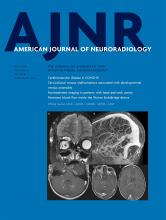Index by author
Afsar, M.
- PediatricsYou have accessIn Vivo Evaluation of White Matter Abnormalities in Children with Duchenne Muscular Dystrophy Using DTIV. Preethish-Kumar, A. Shah, M. Kumar, M. Ingalhalikar, K. Polavarapu, M. Afsar, J. Rajeswaran, S. Vengalil, S. Nashi, P.T. Thomas, A. Sadasivan, M. Warrier, A. Nalini and J. SainiAmerican Journal of Neuroradiology July 2020, 41 (7) 1271-1278; DOI: https://doi.org/10.3174/ajnr.A6604
Agerskov, S.
- Adult BrainYou have accessVentricular Volume Is More Strongly Associated with Clinical Improvement Than the Evans Index after Shunting in Idiopathic Normal Pressure HydrocephalusJ. Neikter, S. Agerskov, P. Hellström, M. Tullberg, G. Starck, D. Ziegelitz and D. FarahmandAmerican Journal of Neuroradiology July 2020, 41 (7) 1187-1192; DOI: https://doi.org/10.3174/ajnr.A6620
Aggarwal, A.
- SpineYou have accessCombination of Imaging Features and Clinical Biomarkers Predicts Positive Pathology and Microbiology Findings Suggestive of Spondylodiscitis in Patients Undergoing Image-Guided Percutaneous BiopsyS. Kihira, C. Koo, K. Mahmoudi, T. Leong, X. Mei, B. Rigney, A. Aggarwal and A.H. DoshiAmerican Journal of Neuroradiology July 2020, 41 (7) 1316-1322; DOI: https://doi.org/10.3174/ajnr.A6623
Ahmed, O.
- Adult BrainOpen AccessHemorrhagic Posterior Reversible Encephalopathy Syndrome as a Manifestation of COVID-19 InfectionA.M. Franceschi, O. Ahmed, L. Giliberto and M. CastilloAmerican Journal of Neuroradiology July 2020, 41 (7) 1173-1176; DOI: https://doi.org/10.3174/ajnr.A6595
Aiken, A.H.
- FELLOWS' JOURNAL CLUBHead & NeckYou have accessPosttreatment Imaging in Patients with Head and Neck Cancer without Clinical Evidence of Recurrence: Should Surveillance Imaging Extend Beyond 6 Months?A. Gore, K. Baugnon, J. Beitler, N.F. Saba, M.R. Patel, X. Wu, B.J. Boyce and A.H. AikenAmerican Journal of Neuroradiology July 2020, 41 (7) 1238-1244; DOI: https://doi.org/10.3174/ajnr.A6614
The authors performed a retrospective data base search that queried neck CT reports with Neck Imaging Reporting and Data Systems scores of 2–4 from June 2014 to March 2018. The electronic medical records were reviewed to determine outcomes of clinical and radiologic follow-up, including symptoms, physical examination findings, pathologic correlation, and clinical notes within 3 months of imaging. A total of 255 cases all with NIRADS scores of 2 or 3 met the inclusion criteria. Fifty-nine patients (23%) demonstrated recurrence, and 21 patients (36%) had clinically occult recurrence. The median overall time to radiologically detected, clinically occult recurrence was 11.4 months from treatment completion. They conclude that imaging surveillance beyond the first posttreatment baseline study was critical for detecting clinically occult recurrent disease in patients with head and neck squamous cell carcinoma. More than one-third of all recurrences were seen in patients without clinical evidence of disease.
Ambady, P.
- Adult BrainOpen AccessDistinguishing Extravascular from Intravascular Ferumoxytol Pools within the Brain: Proof of Concept in Patients with Treated GlioblastomaR.F. Barajas, D. Schwartz, H.L. McConnell, C.N. Kersch, X. Li, B.E. Hamilton, J. Starkey, D.R. Pettersson, J.P. Nickerson, J.M. Pollock, R.F. Fu, A. Horvath, L. Szidonya, C.G. Varallyay, J.J. Jaboin, A.M. Raslan, A. Dogan, J.S. Cetas, J. Ciporen, S.J. Han, P. Ambady, L.L. Muldoon, R. Woltjer, W.D. Rooney and E.A. NeuweltAmerican Journal of Neuroradiology July 2020, 41 (7) 1193-1200; DOI: https://doi.org/10.3174/ajnr.A6600
Ancona-lezama, D.
- EDITOR'S CHOICEPediatricsYou have accessIntra-Arterial Chemotherapy for Retinoblastoma in Infants ≤10 kg: 74 Treated Eyes with 222 IAC SessionsA. Sweid, B. Hammoud, J.H. Weinberg, P. Texakalidis, V. Xu, K. Shivashankar, M.P. Baldassari, S. Das, S. Ramesh, S. Tjoumakaris, C.L. Shields, D. Ancona-Lezama, L.-A.S. Lim, L.A. Dalvin and P. JabbourAmerican Journal of Neuroradiology July 2020, 41 (7) 1286-1292; DOI: https://doi.org/10.3174/ajnr.A6590
Intra-arterial chemotherapy (IAC) for retinoblastoma (Rb) has dramatically altered the natural history of the disease. Cure rates, globe salvage, and vision preservation have dramatically increased. This retrospective chart review evaluated 207 Rb tumors of 207 eyes in 196 consecutive patients who underwent 658 IAC infusions overall. Patient weights were ≤10 kg in 69 (35.2%) and >10 kg in 127 (64.8%) patients. Comparison (≤10 kg versus >10 kg) revealed that the total number of IAC infusions was 222 versus 436. Periprocedural complications were not significantly different. The authors conclude that intra-arterial chemotherapy in patients weighing ≤10 kg is a safe and effective treatment.
Antonucci, M.U.
- LETTEROpen AccessNeuroradiologists and the Novel CoronavirusM.U. Antonucci, J.M. Reagan and M. YazdaniAmerican Journal of Neuroradiology July 2020, 41 (7) E50; DOI: https://doi.org/10.3174/ajnr.A6596
Atchley, T.
- Head & NeckYou have accessPrevalence of Sigmoid Sinus Dehiscence and Diverticulum among Adults with Skull Base CephalocelesH. Sotoudeh, G. Elsayed, S. Ghandili, O. Shafaat, J.D. Bernstock, G. Chagoya, T. Atchley, P. Talati, D. Segar, S. Gupta and A. SinghalAmerican Journal of Neuroradiology July 2020, 41 (7) 1251-1255; DOI: https://doi.org/10.3174/ajnr.A6602
Badger, T.M.
- PediatricsOpen AccessBrain Cortical Structure and Executive Function in Children May Be Influenced by Parental Choices of Infant DietsT. Li, T.M. Badger, B.J. Bellando, S.T. Sorensen, X. Lou and X. OuAmerican Journal of Neuroradiology July 2020, 41 (7) 1302-1308; DOI: https://doi.org/10.3174/ajnr.A6601



